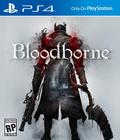Buy Bloodborne
Despite its name and role as a new IP, Bloodborne is a spin-off of Demon's Souls and Dark Souls. Directed by Hidetaka Miyazaki, the man responsible for both of those games, it's an interesting divergence from the Souls titles. It has a number of familiar mechanics and gameplay decisions, and it's very easy to expect another Souls sequel. Bloodborne will appeal to fans of the From Soft titles, but it also has a bloody flavor all its own.
Bloodborne is set in the ruined Victorian-style city of Yharnam, where a plague has transformed most of the citizens into bloodthirsty monsters. The only ones who walk the streets are the infected — and the hunters, who seek to cull the number of infected. As soon as the player arrives in Yharnam, he's waylaid and given a blood transfusion of tainted blood. It's necessary to survive, but it's the first step down a dark path. Yharnam's secret can only be discovered by delving into the city's ruins and facing horrifying monstrosities.
Almost everything familiar from the Souls franchise appears in Bloodborne in one form or other, but many have a new twist. Death plays out much in the same way. If you die, you lose all of your resources (Blood Echoes instead of Souls). They appear as a bloodstain on the ground, and if you can get back there without dying, you can recover the resources. The twist is that enemies can absorb your bloodstain and need to be killed to recover your blood echoes.
Combat has trick weapons that have two forms, and you can switch between the two forms at any time — even mid-combo. Overall, Bloodborne has fewer weapons than the Souls games, but each weapon is more distinctive. A hatchet can transform into a spear, and a cane can turn into a whip. Then there's my favorite, the Kirkhammer. You can draw the sword from the stone to stab foes with a fast and reliable blade, or you can keep the sword embedded in the stone and use the entire thing as a brutal, slow two-handed hammer.
Another big change is the addition of guns, which don't do much damage but are meant to counter enemy attacks because they fire incredibly quickly. If you hit an enemy with a gunshot at the right time in his attack animation, he's stunned and vulnerable to attack, similar to ripostes in Dark Souls. Different guns have different advantages. Some are more powerful but slower, others fire quickly but do almost no damage. Ammo conservation is important, since your guns don't have infinite ammo. Guns use quicksilver bullets, which are special ammo dipped in human blood. You can get more bullets in the field in exchange for some health.
One of the most interesting features in Bloodborne is the Regain system. It's easy to hear "regenerating health" and get worried, but this system is rather genius. When you take damage from an enemy, there is a brief period when your health bar does not deplete entirely. Any damage you do to enemies during this window is returned to your health bar. Taking damage usually means you want to back off and recover, but here, it means you should go all-in to regain what you lost. You'll also recover health from dead enemies for a brief period of time.
This leads to play style choices that aren't available in the other Souls games. Straight-up brawling is a valid play style, if a risky one. Against singular opponents, you can usually come out ahead. Against multiple opponents, you need to utilize clever positioning to hit multiple enemies at once, or you'll need to manage your aggression and avoid committing too hard.
Bloodborne is an incredibly aggressive game. The Souls titles favor caution and careful planning, but here, those traits are secondary to the willingness to tackle danger. Enemy attack patterns are more dangerous if you stay back and bait them. Stay close and launch parries, counters and dodges to significantly prolong your lifespan. With the Regain system, you'll have more health if you're constantly on the offensive. This means Bloodborne favors twitch gameplay skills. If you favored riposte-and-dodge builds in Dark Souls, you'll feel right at home here. If you preferred tanky, slow, defensive builds, you'll have to reconsider your play style. There are defensive options available, but they reward you for getting in the enemy's face. Health can be recovered by finding blood vials from defeated foes, but as the game progresses, these become rarer, so you must abandon your progress to heal or dive in without a safety net.
The difficulty level is difficult to judge. It's more viable to smash your way through weaker enemies, but the more aggressive play style means you can easily get overwhelmed after a misstep. If you approach Bloodborne as a mindless hack-and-slash, you won't get past the opening area. For newcomers, the difficulty curve is a little smoother than in the Souls games, but there is no tutorial, and even the very first enemies can — and probably will — kill you.
Bloodborne is remarkably fair. You're required to die to advance, but it'll usually happens because you're being too aggressive or too cavalier, or due to a mistake on the player's part. The only punishment for death is that you must return to where you died to re-collect your resources. Insight, a new gameplay mechanic, increases as you encounter terrifying things in the game. With higher Insight levels, you encounter new enemies or new enemy attack patterns. This plays into rewarding players for aggression, so it's better to take risks for rewards than to play cautiously.
The level design is a healthy mix of the previous Souls games. The world is large and interconnected, and it's comprised of branching paths through different areas. A huge chunk of the game involves finding shortcuts and paths to open up the world for exploration. Lanterns, which are Bloodborne's version of Bonfires, are pretty rare. You'll have one or two lanterns in an area, and the game encourages you to find shortcuts that make it easier to reach the lanterns. There's also a central hub area where you can rest, relax, buy, and teleport to an existing lantern. There are various NPCs scattered around the areas, and some can lead to side-quests and special tasks.
While there are clearly delineated paths, you're handsomely rewarded for venturing off the beaten trail. This is the best way to find shortcuts, earn Insight, gain special equipment and valuable items, and get your bearings in the environment. You also run into terrifying foes, but even if you wander into the wrong area and get slammed by a boss, you'll still gain some extra Insight for your trouble. Bold Hunter's Mark items are plentiful and allow you to retreat from danger while retaining your blood echoes — if you don't get killed before you can use it.
Bloodborne has many different kinds of multiplayer modes, and many will be familiar to Souls vets. There is the asynchronous multiplayer in the form of spectral images of other players imported from their games. This allows you to see how other players died in the same area and be forewarned of danger. Players can also leave messages on the ground to warn of upcoming danger or point out hidden paths. By spending Insight, you can summon players to help take on bosses. On the other hand, players can also invade your game and try to stop you from beating a boss. There are a few new twists, but I don't want to spoil them.
A new multiplayer feature is the Chalice Dungeon, which is a randomly generated dungeon that can be accessed once you find a specific in-game item. These dungeons represent what is sure to be the bulk of Bloodborne's gameplay to many people. They're full of traps, enemies, and danger, and they feature special bosses you won't encounter anywhere else in addition to more difficult and deadly versions of foes. You can take on Chalice Dungeons with friends or be invaded by rivals. These dungeons aren't as well polished as the main game, but they make up for it with the sheer amount of fresh content. The procedural generation means the experience is different each time, and there's enough Chalice-exclusive content that it feels like a coherent part of the design, rather than an afterthought.
Bloodborne is easily From Software's best-looking game. The art design is phenomenal, and almost every aspect looks top-notch. The character models are uncomfortably creepy, and some of the bosses are breathtaking. However, the title suffers from the usual Souls frame rate issues. It generally hangs around 30 fps, but there are times when it drops, especially in areas with a lot of fire or other particle effects. The loading times are also rather long, although you only see them after death or when teleporting to your home base.
The star is the sound design. The monsters might look creepy, but they sound terrifying. Hearing a wolf monster screech like a demon as it flies at you from the mist is enough to make even the most hardened of hunters flinch. The whispers, moans and groans are extremely unnerving. Some of the human voice acting is a little weak, but generally, it has the same stilted tone as the other Souls games, which actually works in its favor rather than against it.
Bloodborne is easily an early contender for game of the year, and it's the best PS4 exclusive to date. It captures the immensely strong design of Dark Souls and mixes it with high-intensity combat. The new setting and mechanics keep the title feeling fresh even while it retains many familiar aspects from the Souls games. Some minor problems, such as an occasionally poor frame rate, lightly tarnish the experience. Bloodborne is a must-have for any gamer who isn't afraid to die. The intense, fast-paced gameplay and grim world combine to create an experience that's both familiar and distinctive. It's time to die all over again.
Score: 9.5/10
More articles about Bloodborne











 Bloodborne is an Action RPG that will transport players to a dark and terror-filled gothic world, a world full of deranged beings and nightmarish creatures.
Bloodborne is an Action RPG that will transport players to a dark and terror-filled gothic world, a world full of deranged beings and nightmarish creatures.















































